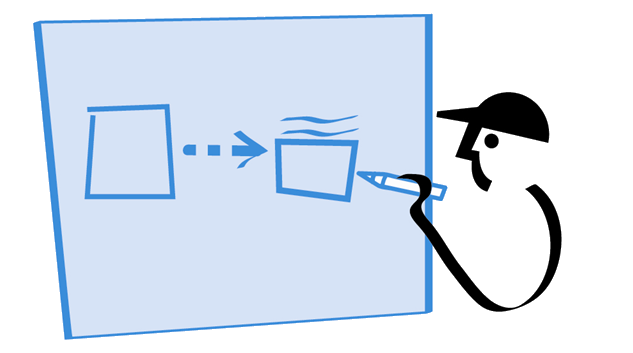What is an A3?A3 is the international term for paper that is roughly 11-by-17 inches A3 planning began in the 1960s as the quality circle problem-solving format. It evolved into a standard format for problem-solving, proposals, plans, and status reviews. It tells a story, laid out from upper left to lower right, which anyone can understand. It lays out an entire plan to solve a problem or make an improvement, large or small, on one sheet of paper |
Problems are part of business. To fix them, you probably launch or participate in problem-solving projects.
But how many projects are truly successful, when success means fixing problems:
- On time
- On budget
- With the desired results
- And sustaining the results
Based on his experience with companies pursuing lean transformations, Eric Ethington, a fellow at the Lean Enterprise Institute (LEI), knows that most traditional problem-solving projects fall far short of expectations. The reason is that the problem-solving process itself is broken, often beset with such difficulties as:
- No agreement among stakeholders on what the problem is
- No buy-in among team members
- Poor planning
- Lack of management support
- Leadership changes
- Changes in scope
- Lack of follow-up
- A new “fire” erupts
The solution, Ethington said, is a robust problem-solving process that does two things: (1) gains alignment and agreement about what the problem is; (2) develops thinking problem-solvers. That means developing an A3 problem-solving process.
“An A3 helps you gain alignment and agreement by telling a story that is a plan to solve the problem,” Ethington told attendees during a breakout session at IndustryWeek’s Best Plants Conference in April 2012. And it develops problem solvers because it encourages initiative and reasoning based on the scientific method of plan-do-check-act (PDCA).
The A3 Process
The A3 takes its name from A3 paper, the international term for paper measuring roughly 11-by-17 inches. (See an A3 template from Managing to Learn by LEI CEO John Shook.)
“What’s not important is the format but the process behind it,” Ethington noted. “It fosters 360-degree communications among a coach, stakeholders, and project team members. This builds agreement, engagement, and consensus.”
The A3 problem-solving process also develops problem solvers because it clarifies links between a problem and possible countermeasures based on facts and data not gut feelings.
“We like to jump to conclusions based on gut feelings, but that gut feeling is often wrong,” said Ethington. He suggested looking at an A3 as “your portable whiteboard, allowing you to have a discussion around a problem.”
While there is “no magic” in the A3 process, there are steps:
- What is the “real” problem? Why does it need to be addressed now?
- Who owns the problem?
- What is the root cause of the problem?
- What are some possible countermeasures?
- How will you choose which countermeasure to propose?
- How will you get agreement among everyone concerned?
- What is your implementation plan? What timetable?
- How will you know if your countermeasure works?
- What implementation issues can you anticipate?
- How will you ensure follow up & continuous improvement?
In the following section, Ethington offers some practical tips for completing or coaching an A3 problem-solving process. There are links to more resources at the end of this article.
Background
- Why you are solving this problem?
- How is it contributing to the company’s business need?
Current Situation
- What is currently happening? Describe the process.
Then
- What should be happening in performance terms (such as – the bearing should have lasted 500 hours but failed at 300 hours).
- What is your performance gap? (Quantifiable difference between the two bullet points above).
- Breakdown the problem/gap into smaller pieces.
- Decide: do you need to prioritize one of the “smaller pieces” to solve first.
Goal/Target
Important factors for setting the goal or target:
- How much?
- By when?
- Use action words like reduce, increase, eliminate.
- Keep in mind what portion of the target or goal you are trying to reduce with the smaller problem selection.
- Avoid words like – create, implement, and develop. They indicate solutions.
Countermeasures
- Always evaluate more than one.
- Evaluate them as a team.
| Problem Type | Possible Countermeasures |
| Quality | Pareto, DOE |
| Delivery | Value-stream map |
| Cost | Pie chart, stacked chart |
| Productivity | Operator balance sheet |
| Organizational | Swim lanes, value-stream map |
|
The tools will always vary from problem to problem |
|
Common Pitfalls
- Assuming that once you think you have the “best solution,”
- Everyone will agree, and
- Therefore – problem solved, job done
- Thinking that defining the solution well is a “plan”
- Assuming that, once you’ve got a plan, everything will go according to that plan.
- Throwing the plan out the window when things go wrong
- Trying to stick to the plan no matter what
In other words, not completing the PDCA cycle.
Coaching or Reviewing an A3
- Use A3 etiquette:
- Seek first to understand
- Let the A3 author present completely, only stop him or her for clarification if there is something you don’t understand
- Ask yourself if you understand the problem? If not, ask “pure inquiry” questions, questions that help you understand without suggesting solutions.
- Does the presenter understand the problem?
- If yes, then continue.
- If no, then that becomes a problem to solve.
- To help the A3 owner with problem solving, consider:
- Is he or she focused on the real problem?
- Is the reason for addressing the problem now clear?
Continue Learning with These A3 Resources
- Managing to Learn: Use of the A3 Management Process workshop
- Managing to Learn workbook by John Shook, reveals the thinking underlying the A3 management process that is at the heart of lean management and lean leadership







